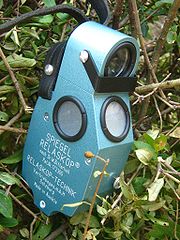
Relascope
Encyclopedia

Walter Bitterlich
Walter Bitterlich was a world-renowned forest scientist. A notable contributions of his to the forestry profession was the invention of the relascope used in forest inventories.- Early Career :...
, is a multi-use instrument for forest inventory
Forest inventory
Forest inventory is the systematic collection of data and forest information for assessment or analysis. It is also commonly known as timber cruising. It is important for owners to cruise the timber to get an estimate of the value and possible uses of the timber...
. It is primarily used to find height of a tree, basal area of a tree and diameter of a tree anywhere along the bole. This instrument is used mostly for applications involving variable radius sample plots in a forest survey.
Method of operation
The relascope has a sight hole on the back and a clear window at the front to allow the user to sight through the tool. There are three light inlet holes which are used to light the scale. This is one of the major problem with the relascope, the way this instrument is designed it cannot be used when light is at a minimum. This is not a problem in a similar piece of equipment called the tele-relascope. This instrument differs from the relascope in that the tele-relascope is an electronic laser based version.Use
The Relascope is used by looking through the hole in the front of the instrument. When one looks through this hole they will see several scales that are used for different measurements on the bottom half of ones view and on the top half one will see the tree that they are looking at. There are three scales for height of the tree used depending on the distance one is from the tree, five scales for diameter and two scales for basal areaBasal area
Basal area is the term used in forest management that defines the cross-sectional area of a tree at DBH, inside the bark.In most countries, this is usually a measurement taken at a specimen's breast height above the ground and includes the entire diameter of every tree, including the bark...
used depending on desired basal area factor.
Function
The Relascope is very similar to the angle gaugeAngle gauge
An angle gauge is a tool used by foresters to determine which trees to measure when using a variable radius plot design in forest inventory. Using this tool a forester can quickly measure the trees that are in or out of the plot. An angle gauge is a very similar tool to a wedge prism though it...
and the wedge prism
Wedge prism
The wedge prism is a prism with a shallow angle between its input and output surfaces. Refraction at the surfaces causes the prism to deflect light by a fixed angle...
in that it can be used to find the basal area of a tree from a point depending on the basal area factor in a variable radius sampling method. The main difference in this instrument though is that it has multiple uses as described previously. Some other advantages over similar devises in that it accounts for the slope one is from the tree giving a more accurate measurement than similar tools.
The Relascope can also be used to find the distance from a tree (range). This is done in the same manner as when one uses a transit
Transit
-Transportation:* Ford Transit, a van made by the Ford Motor Company* Mass transit, public transport systems in which passengers are carried in large numbers* Navigational transit, when a navigator observes two fixed reference points in line...
using a set of trigonometric formulae based on height and angle. The Relascope is not commonly used for this because of its difficulty and the amount of time it takes to do this.
Tree height is another use of this instrument. It does this by using several weighted wheels that spin based on the position of the instrument. The readings off of this scale will give the height of the tree based on your position from the tree. When taking height one measures either 66 or 120 feet from the tree this is the reason for the multiple scales in the relascope. When one stands at this distance they look first at the top of the tree or at the highest point on the bole that they want to measure and record the number from the height dial inside the scope, then one looks at the bottom of the tree this will give you a positive or negative number you take this number and subtract it from the first number one recorded this is ones height of the tree. This is very similar to the way a clinometer
Clinometer (forestry)
The clinometer, known in many fields as an inclinometer, is a common tool used in forestry to measure slope, vertical angles, and – in combination with distance measurements – elevation change or tree heights.-How it works:...
is used.
Point sampling


